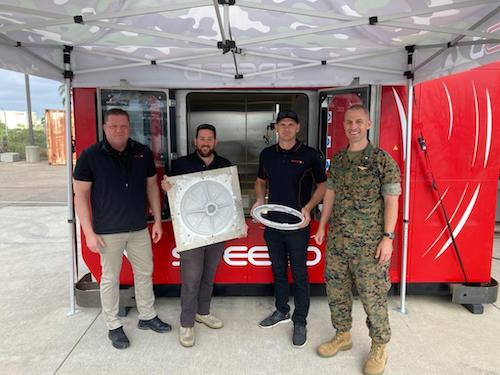SPEE3D Goes to Boot Camp
SPEE3D reports to the Marine Corps Integrated Training Exercise (ITX) to 3D print broken parts to support critical defense operations.

SPEE3D prints on-demand parts in the field as part of the Marine Corps Integrated Training Exercise (ITX). Image Courtesy of SPEE3D
Latest News
August 10, 2023
The Marine Corps Annual Integrated Training Exercise (ITX) is the largest Marine Corps Reserve exercise of the year—a live-fire event combining infantry, artillery, aircraft, combat logistics, and now, 3D printing—to help troops hone skills and practice increasingly complex military tactics.
In addition to a series of events and exercises that tested the mettle of 3,700 Marines and sailors over the course of a month, one AM company, SPEE3D, was on-hand at ITX 4-23 to deploy its WarpSPEE3D system to print crucial metal parts that might break during the aggressive training exercises. The live-fire exercises are designed to train battalion and squadron-sized units in the tactical application of combined-arms maneuvers and offensive and defensive operations during combat.
Any metal parts that break during the training process were brought from ground support at the Marine Corps Air Station in Miramar, CA, and flown to the live-fire Marine Corps Air Ground Combat Center, also in CA. The WarpSPEE3D printer output critical parts at point-of-need—a capability it has repeatedly demonstrated in other defense-related deployments and military field trials with the U.S., U.K., and Australian militaries over the last few years.
Military and defense requires on-demand technology to quickly produce parts from well-known metal alloys to address real-time needs in-theater, helping maximize availability and minimizing downtime. During ITX 4-23, a team at the Consortium for Additive Manufacturing Research and Education (CAMRE) leveraged the WarpSPEE3D platform to manufacture a baseplate, an industrial-grade metal part, in hours, not weeks. CAMRE is based at the Naval Postgraduate School in Monterey, CA.
The baseplate, weighing in at 31 pounds and made of aluminum, was printed in 12 hours, according to CAMRE. Its role was to lift a 22,000 pound Humvee vehicle shortly after it was produced and post-processed in the field.
“SPEE3D repeatedly demonstrated its ability to 3D print metal replacement parts outdoors, in an expeditionary environment,” said Chris Curran, program manager for CAMRE, in a press release. “What was impactful was their ability to produce parts in a matter of hours – not days – which could potentially offer warfighters and maintainers a competitive advantage in a contested environment.”
WarpSPEE3D is a large-format metal 3D printer that employs SPEE3D’s patented Cold Spray Additive Manufacturing (CSAM) technology, which enables fast, cost-effective, scalable production. The patented technology uses supersonic deposition in which a rocket nozzle accelerates air up to three to four times the speed of sound. Injected powders are then deposited onto a substrate that is attached to a six-axis robotic arm, and it’s the sheer kinetic energy of the particles that facilitates the binding process that forms a high-density part.
Additionally, SPEE3D offers XSPEE3D, explicitly designed for military and other in-field applications. XSPEE3D is a containerized, ruggedized, deployable metal AM solution that delivers all the necessary functions to build metal parts in a portable metal shipping container.
Watch this video to learn more about SPEE3D’s XSPEE3D containerized metal manufacturing solution for military and other applications.
Subscribe to our FREE magazine, FREE email newsletters or both!
Latest News
About the Author
Beth Stackpole is a contributing editor to Digital Engineering. Send e-mail about this article to [email protected].
Follow DE





